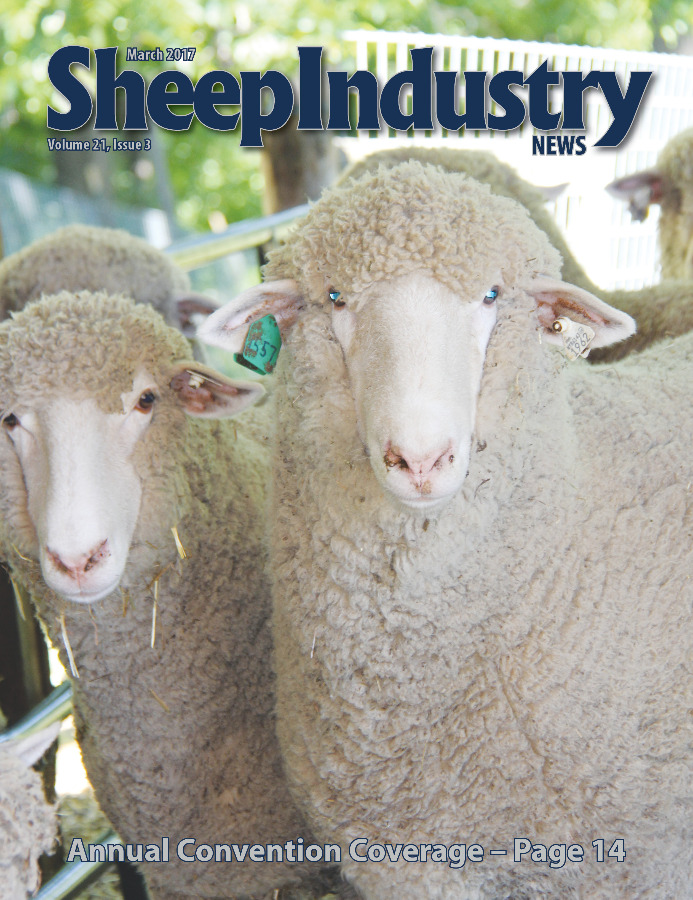
- March 2017
- President’s Notes
- Montana Sheep Conflicts Examined
- ASI Headed to Washington this Month
- Hahn Tops Shearing Field
- Convention: American Wool…Branded for the Future
- Convention: Branding American Wool
- Convention: Officers, Executive Board Elected
- Convention: Industry Veterans Honored
- Convention: Abiding by VFD Regulations
- Convention: States Share Highlights, Challenges
- Convention: Social Media Takes Center Stage
- Convention: FMD Focus of Animal Health
- Convention: WS Aerial Program a Priority
- Convention: Preparing for the New Farm Bill
- Convention: PERC Hears from Researchers
- Convention: EBVs Pay Off for Producers
- Convention: Lamb News is Encouraging
- Convention: The Fleece Awakens at MIWW
- Webinars Prove Informative
- Round 5 of Let’s Grow Grants Open
- Market Report
- The Last Word
Abiding by VFD Regulations
CAT URBIGKIT
Special to the Sheep Industry News
New federal rules regulating how medically important antibiotics can be administered to animals in feed and drinking water require veterinary oversight, according to Meg Oeller, DVM, Ph.D., of FDA’s Center for Veterinary Medicine.
Once available over the counter, all medically important antibiotics used in feed or water now require a Veterinary Feed Directive (for feed use) or a prescription (for water use). The rule does not affect injectable antibiotics (such as generic penicillin) or dewormers, but focuses only on antibiotics used in feed and water.
Oeller addressed the information session of the ASI board of directors, telling producers, “Don’t panic, I’m here to talk you down off the ledge.”
The new rules were needed because of growing concern about antibiotic resistance. The use of an antibiotic, especially at a low dose, can kill weak bacteria while leaving the strong (resistant) ones to multiply. These drugs can no longer be used for production purposes (such as increased weight gain or feed efficiency), but must instead be used for therapeutic purposes under the supervision of a veterinarian.
The VFD requires a valid veterinarian-client relationship, Oeller explained, meaning that the vet has to know you and your farm, and must be available for follow-up, if needed.
“Most producers already have vets,” Oeller noted. “Be sure your vet understands your needs.”
The FDA has already worked with drug makers to approve applications for the following VFD medicated feeds: apramycin, hygromycin B, neomycin, streptomycin, ormetoprim, lincomycin, erythromycin, tylosin, Virginiamycin, sulfadimethoxine, sulfamerazine, sulfamethazine, sulfaquinoxaline, chlortetracycline, and oxytetracycline. Most (but not all) of these same drugs are also on the approved list for prescriptive use in drinking water, as is penicillin.
When your vet needs to prescribe antibiotics for use in feed, the vet will prepare a VFD for your feed mill, which is a written statement authorizing the use of a VFD drug (or drug combination) in or on animal feed; the species and production class and an approximate number of animals to be treated; the level of drug in the feed and the duration of use; withdrawal time; and the disease or condition indicating the need for the drug use. The VFD will include the date of the issuance, as well as the expiration date, which can be up to six months, so the VFD can be given in advance based upon predicted events. The VFD must include specific information, including a statement that VFD use is prohibited.
So what medicated feeds are approved for sheep, and to treat what condition?
AVAILABLE VIA VFDS:
• Chlortetracycline – vibrionic abortion
• Oxytetracycline (and + neomycin) – bacterial enteritis, pneumonia
• Neomycin – bacterial enteritis
AVAILABLE AS OVER-THE-COUNTER MEDICATED FEEDS:
• Thiabendazole – roundworms
• Decoquinate – coccidiosis
• Lasalocid – coccidiosis
Water medications approved for sheep via prescription include oxytetracycline (for bacterial enteritis and pneumonia) and neomycin (for bacterial enteritis).
Although there are few approved medicated feeds available for use in sheep, Oeller said the FDA recognizes the problem this poses for producers. Legal extra-label drug use is allowed when there is no approved product available for the use, and is allowed for dosage-form drugs (water medications, etc.) but not for medicated feed.
The FDA has issued a Compliance Policy Guide directing enforcement discretion to field inspectors as a way to allow otherwise restricted uses. This CPG, if followed, provides a way to avoid enforcement action. Under the CPG, when there are no approved treatment options available, the health of animals is threatened and failure to treat affected animals would result in suffering or death, the VFD use of medicated feeds may be considered for treatment of minor species such as sheep as long as the conditions and procedures described in the CPG are followed. To learn more, visit
FDA.gov/AnimalVeterinary/NewsEvents/CVMUpdates/ucm529164.htm.
The CPG is a short-term solution, Oeller said, but in the end, more animal drug approvals are needed. The USDA’s Minor Use Animal Drug Program with FDA’s Dr. Amy Omer is currently working on the studies needed to support approval of more products for use in sheep and goats, including using tulathromycin to treat respiratory disease in sheep and goats. Other projects will address chlortetracycline for respiratory disease in sheep, and meloxicam for pain, fever and inflammation in sheep.
“I think it’s all do-able,” Oeller said, as more producers, veterinarians and feed mills become accustomed to the new antimicrobial use requirements, and more drugs are approved to treat specific conditions in sheep and goats.
ONLINE RESOURCES:
For label claims and marketing status of medicated feeds, as well as a list by state of approved feed mills and a searchable database of approved animal drugs, check online at FDA.gov. Follow the links to Animal & Veterinary, Products, Animal Food & Feeds, Medicated Feeds.

